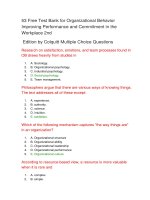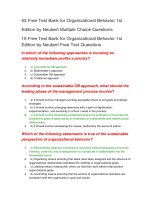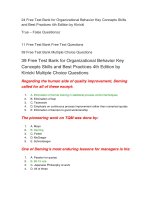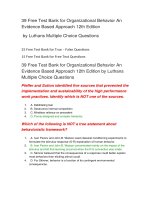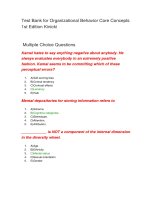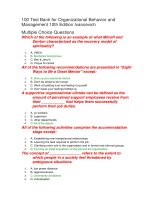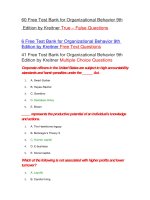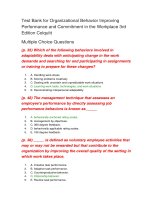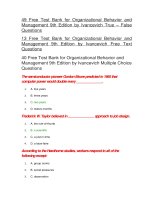126 test bank for organizational behavior integrating individuals groups and organizations 3rd edition champoux
Bạn đang xem bản rút gọn của tài liệu. Xem và tải ngay bản đầy đủ của tài liệu tại đây (112.78 KB, 19 trang )
126 Test Bank for Organizational Behavior Integrating
Individuals Groups and Organizations 3rd Edition
Champoux
Multiple Choice Questions - Page 1
_________________ coined the phrase gold in the mine to
refer to long-term payoffs of quality management.
1.
2.
3.
4.
A. Walter A. Shewhart.
B. Armand V. Feigenbaum.
C. Joseph M. Juran.
D. W. Edwards Deming.
The expected gender profile of the labor force in 2010 shows
1.
2.
3.
4.
A. 25% women.
B. 48% women.
C. 64% women.
D. 75% women.
Quality management’s roots lie in
1.
2.
3.
4.
A. service.
B. manufacturing.
C. customer satisfaction.
D. the public sector.
Quality management’s roots can be traced to the
1.
2.
3.
4.
A. 1920s.
B. 1940s.
C. 1970s.
D. 1980s.
Which of the following is true about the technology context
of modern organizations?
1.
A. Managers now have more organizational design options to build flexible,
responsive organizations than ever before.
2. B. Computing technologies have reshaped manufacturing processes worldwide.
3. C. Communication technologies let people stay connected, no matter where they
are in the world.
4. D. All answers are true about the technology context of modern organizations.
Which of the following is not a quality management tool or
technique?
1.
2.
A. flowchart
B. path analysis
3.
4.
C. benchmarking
D. Pareto chart
Which of the following is not true about the context of
modern organizations?
1.
2.
3.
4.
A. technology effects on organizations
B. decreasing global emphasis of managers
C. increasing workforce diversity
D. emphasis on managing for quality
Quality management applies to which of the following
aspects of organizations?
1.
2.
3.
4.
A. production
B. service
C. processes
D. Each answer is an organizational aspect to which quality management applies.
Which of the following is true about the workforce diversity
context of modern organizations?
1.
A. Workforce diversity brings people into organizations with vastly different ways of
thinking about their environment.
2. B. Managers need to harness those differences to reach organizational goals
successfully.
3. C. Workforce diversity can increase an organization’s conflict potential.
4. D. All answers are true about the workforce diversity context of modern
organizations.
Genichi Taguchi is a major Japanese contributor to quality
management. Which of the followingperspectives or
tools did Taguchi bring to QM?
1.
2.
A. He viewed any lack of quality as a loss to society.
B. Taguchi developed a “loss function” to measure the costs of quality losses that
decision makers could use to guide their QM efforts.
3. C. Taguchi applied experimental design to quality assessment.
4. D. Each answer is a perspective or tool from Taguchi.
The person who developed a quality control method that
involved people both within and outside a quality
control department was
1.
2.
3.
4.
A. Walter A. Shewhart.
B. Armand. V. Feigenbaum.
C. Joseph M. Juran.
D. W. Edwards Deming.
Which of the following is not a quality management tool or
technique?
1.
2.
3.
4.
A. control chart
B. checksheet
C. variance analysis
D. cause and effect diagram
_________________ was the first to recognize that process
abnormalities caused variability in manufacturing
processes.
1.
2.
3.
4.
A. Walter A. Shewhart.
B. Armand. V. Feigenbaum.
C. Joseph M. Juran.
D. W. Edwards Deming.
Which of the of the following people do the Japanese view as
the most important contributor to their quality
management methods?
1.
2.
3.
4.
A. Walter A. Shewhart
B. Armand. V. Feigenbaum
C. Joseph M. Juran
D. W. Edwards Deming
American organizations started to embrace quality
management in the
1.
2.
3.
4.
A. 1920s.
B. 1940s.
C. 1970s.
D. 1980s.
Which of the following statements is true about quality
management?
1.
2.
3.
4.
A. A goal of quality management is increased profit.
B. A goal of quality management is long-term cost reduction.
C. A goal of quality management is statistical control.
D. A goal of quality management is continuous quality improvement.
Which of the following statements is not true about
managing for diversity?
1.
2.
3.
4.
A. Channel the potential of a diverse workforce toward the organization’s goals.
B. Personnel policies stay the same as before workforce diversity increased.
C. Actively preserve a diversity of viewpoints.
D. Help employees get the satisfaction they want from their work experience.
Kaoru Ishikawa is a major Japanese contributor to quality
management. Which of the followingperspectives or
tools did Ishikawa bring to QM?
1.
2.
3.
4.
A. statistical quality control
B. quality control circles
C. Ishikawa emphasized human factors in QM.
D. Each answer is a perspective or tool from Ishikawa.
Which of the following is not a reason that managing for
diversity is good business strategy?
1.
2.
3.
4.
A. Organizations must offer services to a wide range of customers.
B. Diversity reduces the amount of organizational conflict.
C. Diversity can help organizations better meet customer expectations.
D. U.S. organizations must compete in global markets.
A manager who compares an organization’s processes to
those of an industry leader is using which of the
following quality management tools or techniques?
1.
2.
3.
4.
A. control chart
B. Pareto chart
C. benchmarking
D. quality function deployment
The racial/ethnic group with the lowest projected growth in
the United States civilian labor force is
1.
2.
3.
4.
A. whites.
B. blacks.
C. Asians.
D. Hispanics.
Managing for diversity features which of the following
characteristics?
1.
A. Harness the potential of all sources of difference within an organization’s
workforce.
2. B. Managers actively tap diverse perspectives and rethink their approach to tasks
and markets.
3. C. Managing for diversity is not affirmative action in disguise.
4. D. All answers are correct.
The expected ethnic profile of the labor force in 2010 shows
1.
2.
3.
4.
A. 15% minority.
B. 32% minority.
C. 46% minority.
D. 57% minority.
Which of the following is not true about managing for quality
in modern organizations?
1.
2.
A. Managing for quality asks managers to continuously improve quality.
B. Mangers do not need to rethink how different parts of their organization
contribute to quality services and products.
3. C. Fully successful quality management usually requires major changes in an
organization’s culture.
4. D. Managing for quality asks managers to focus on customer desires.
Which of the following is not a major emphasis of quality
management?
1.
2.
3.
4.
A. processes
B. customers
C. chain-of-command
D. interdependence with suppliers
53 Free Test Bank for Organizational Behavior
Integrating Individuals Groups and Organizations
3rd Edition Champoux Multiple Choice Questions
- Page 2
Country cultures that prefer to act as members of groups
are
1.
2.
3.
4.
A. low individualism.
B. low masculinity.
C. low uncertainty avoidance.
D. high uncertainty avoidance.
The dimension of country cultures that describes the degree
of inequality among people that the culture considers
normal is
1.
2.
3.
4.
A. power distance.
B. uncertainty avoidance.
C. individualism.
D. masculinity.
Which of the following statements is false about the quality
management process?
1.
2.
3.
4.
A. Quality management is a long-term process.
B. Communication is primarily top-down.
C. Quality management is customer focused.
D. Managers can create a climate of high work involvement.
Quality management research has shown which of the
following results?
1.
2.
3.
A. Continuous improvement efforts increase process efficiency and reduce costs.
B. Quality can attract new customers and increase the retention of old ones.
C. Some quality management efforts produced poor results because managers did
not target improvements to areas with the greatest long-term positive effect on
profits.
4. D. All answers are correct.
People in countries that rely less on formal rules and more
on direct interpersonal interactions are
1.
2.
3.
4.
A. low power distance and low uncertainty avoidance.
B. low power distance and high uncertainty avoidance.
C. high power distance and low uncertainty avoidance.
D. high power distance and high uncertainty avoidance.
A quality management tool for translating customer needs
into engineering requirements is
1.
2.
3.
4.
A. quality function deployment.
B. benchmarking.
C. Pareto chart.
D. control chart.
Country cultures that value flexibility and prefer few formal
rules are
1.
2.
3.
4.
A. low power distance.
B. short-term orientation.
C. low masculinity.
D. low uncertainty avoidance.
Mexico is
1.
2.
3.
4.
A. high power distance and low uncertainty avoidance.
B. high power distance and high uncertainty avoidance.
C. low power distance and high uncertainty avoidance.
D. low power distance and low uncertainty avoidance.
The best tool to let a manager count product defects is a
1.
2.
3.
4.
A. checksheet.
B. flowchart.
C. control chart.
D. Pareto chart.
A quality management technique that shows whether
process variability is within control limits is
1.
2.
3.
4.
A. variance analysis.
B. benchmarking.
C. quality function deployment.
D. control charting.
Cultures that prefer participation in management are likely
1.
2.
3.
4.
A. high masculinity.
B. low long-term orientation.
C. high individualism.
D. low power distance.
Changes in computing and communications technology
include which of the following?
1.
A. High-speed computer processors and large memory capacity let you create
animated three-dimensional business presentations.
2. B. Laptop and palmtop computers allow connections to the Internet from airport
and aircraft telephones or cyber cafés.
3. C. Wave division multiplexing technology uses the multiple colors of a single beam
of light as communication channels.
4. D. All answers are correct.
Which of the following groups is least likely to be involved
with a quality management analysis team examining
the organization’s hiring process?
1.
2.
3.
4.
A. human resources
B. union representatives
C. accounting
D. newly hired employees
People in countries that prefer well-defined procedures to
guide daily behavior, with managers settling
exceptional matters, are
1.
2.
3.
4.
A. low power distance and low uncertainty avoidance.
B. low power distance and high uncertainty avoidance.
C. high power distance and low uncertainty avoidance.
D. high power distance and high uncertainty avoidance.
China is
1.
2.
3.
4.
A. high power distance and low uncertainty avoidance.
B. high power distance and high uncertainty avoidance.
C. low power distance and high uncertainty avoidance.
D. low power distance and low uncertainty avoidance.
A manager who uses a line graph to show a process’s
performance over time is using a
1.
2.
3.
4.
A. Pareto chart.
B. flow chart.
C. control chart.
D. function chart.
Cultures that place a high value on warm interpersonal
relationships and act with caring are low on
1.
2.
3.
4.
A. masculinity.
B. power distance.
C. uncertainty avoidance.
D. individualism.
Cultures in which people function well working in teams are
likely
1.
2.
3.
4.
A. high masculinity.
B. low individualism.
C. high long-term orientation.
D. low uncertainty avoidance.
Cultures that place a high value on decisiveness,
assertiveness, and independence are high on which
dimension?
1.
2.
3.
4.
A. uncertainty avoidance
B. power distance
C. individualism
D. masculinity
Which of the following describes modern organizations and
management?
1.
2.
3.
4.
A. flexible strategies focused on customer needs and global markets
B. decentralized organizational designs
C. wide use of self-managing work teams
D. Each answer describes modern organizations and management.
Which of the following is true of manufacturing in the
future?
1.
2.
3.
4.
A. almost no inventory
B. direct links to customers or end-users
C. mixing custom-made items and long production runs
D. All answers are correct.
A quality management tool that shows the steps and the
relationships among steps in a process is
1.
2.
3.
4.
A. checksheet.
B. flowchart.
C. control chart.
D. Pareto chart.
Country cultures that place a high value on predictability and
structure are high in
1.
2.
3.
4.
A. power distance.
B. masculinity.
C. uncertainty avoidance.
D. long term.
Sweden is
1.
2.
3.
4.
A. high power distance and low uncertainty avoidance.
B. high power distance and high uncertainty avoidance.
C. low power distance and high uncertainty avoidance.
D. low power distance and low uncertainty avoidance.
A manager who wants to isolate major problems from minor
ones as part of quality management would likely use a
1.
2.
3.
4.
A. checksheet.
B. Pareto chart.
C. flowchart.
D. control chart.
Cultures that prefer autocratic management styles are likely
1.
2.
3.
4.
A. low masculinity.
B. low uncertainty avoidance.
C. high power distance.
D. short-term orientation.
Which of the following is a manufacturing innovation?
1.
2.
3.
4.
A. robotics
B. laser cutting
C. new materials and bonding methods
D. Each answer is a manufacturing innovation.
Which of the following countries is most likely to rely on
middle management to coordinate activities?
1.
2.
3.
A. Austria
B. China
C. Mexico
4.
D. United States
True - False Questions
QM is not a worldwide phenomenon. It is limited to the
United States or Japan.
1.
2.
True
False
High costs of improving quality were a reason that some
quality management efforts failed.
1.
2.
True
False
A. V. Feigenbaum coined the phrase gold in the mine to refer
to the long-term payoffs of quality management.
1.
2.
True
False
Managers who value diversity aggressively embrace it and
actively try to build a diverse workforce.
1.
2.
True
False
Quality function deployment is a quality management tool
that translates customer needs into engineering
requirements.
1.
2.
True
False
Quality management is a Japanese invention.
1.
2.
True
False
A goal of quality management is continuous improvement in
products, services, and processes.
1.
2.
True
False
Quality management primarily emphasizes lateral
communication processes.
1.
2.
True
False
A goal of quality management is increased profit.
1.
2.
True
False
Quality management includes getting feedback from
suppliers and customers.
1.
2.
True
False
Modern managers do not need to develop a global mindset.
1.
2.
True
False
Organizations increasingly use intranets and connections to
the Internet, changing the form of human interaction.
1.
2.
True
False
Union status is a dimension of workforce diversity.
1.
2.
True
False
An organization’s mission statement should clearly state
how members should reach organizational goals.
1.
2.
True
False
The Japanese view W. E. Deming as the most important
contributor to their quality management techniques.
1.
2.
True
False
Changes in computing power, computer features, and
communication technology have few effects on
organizations and management now and into the
future.
1.
2.
True
False
The age range with the highest projected growth in the U.S.
civilian labor force is 55 and older.
1.
2.
True
False
Technology is not part of the context of modern
organizations.
1.
2.
True
False
Managing for quality asks managers to focus on customer
desires and continuously improve quality.
1.
2.
True
False
Quality management takes a total system’s view, extending
beyond organizational boundaries.
1.
2.
True
False
The Taguchi method is a set of techniques that applies
experimental design to quality assessment.
1.
2.
True
False
Having a diverse workforce helps managers attract
customers from diverse backgrounds.
1.
2.
True
False
W. E. Deming’s work had a profound effect on American
management practices in the 1940s.
1.
2.
True
False
Managing diversity is a good business strategy.
1.
2.
True
False
Quality management applies only to manufacturing firms.
1.
2.
True
False
Managing diversity asks people to give up their individuality
and take on the values of the majority.
1.
2.
True
False
Increasing workforce diversity has little effect on an
organization’s conflict levels.
1.
2.
True
False
A diverse workforce can help a company better meet
customer needs.
1.
2.
True
False
Pareto charts help isolate major problems from minor ones.
1.
2.
True
False
Quality awards exist in different countries and world
regions.
1.
2.
True
False
Quality function deployment is a method of comparing an
organization’s process to an accepted leader.
1.
2.
True
False
American organizations began to heavily embrace quality
management in the 1920s.
1.
2.
True
False
Analysis teams used as part of quality management have
people from all parts of the organization.
1.
2.
True
False
The projected growth in the U.S. civilian labor force is
expected to be greater for men than women.
1.
2.
True
False
Managing for diversity is another term for affirmative action.
1.
2.
True
False
Sexual orientation is a dimension of workforce diversity.
1.
2.
True
False
Country cultures that believe others should be treated as
equals despite social status are low in power distance.
1.
2.
True
False
Different worldviews held by members of a diverse
workforce decrease the potential for conflict in an
organization.
1.
2.
True
False
Managing for diversity and affirmative action are the same
ideas.
1.
2.
True
False
Palm-size communication devices let managers send and
receive e-mail, connect to the Internet, and talk to a
person on the telephone from almost anywhere in the
world.
1.
2.
True
False
Workforce diversity and quality management are two parts of
the context of modern organizations.
1.
2.
True
False
Cultures that value flexibility and few formal rules are high in
uncertainty avoidance.
1.
2.
True
False
The European countries that adopted the euro will see few
effects of its adoption on freer trade.
1.
2.
True
False
The Internet has little effect on worldwide business and
commerce.
1.
2.
True
False
Free Text Questions
The Japanese consider the most important contributor to
their quality management methods to be
______________.
Answer Given
W. Edwards Deming or Deming
Workforce diversity brings people into organizations with
vastly different ______________ or ______________
about their environment.
Answer Given
worldviews, ways of thinking
Quality management emphasizes ______________ and
______________.
Answer Given
continuous quality improvement, customer focus, quality is everyone’s job, or
process view
The age range with the highest projected growth in the U.S.
civilian labor force is ______________.
Answer Given
55 and over
The quality management technique showing whether
process variability is within control limits is
______________.
Answer Given
control charting
The first person to recognize that process abnormalities
could cause manufacturing process variability was
_______________.
Answer Given
Walter A. Shewhart or Shewhart
The quality management tool that compares an
organization’s processes to those of an industry
leader is ______________.
Answer Given
benchmarking
Modern computing and communication technology bring
new ______________ and ______________ to
managers of modern organizations.
Answer Given
opportunities, challenges
Mexico is ______________ in uncertainty avoidance and
______________ in power distance.
Answer Given
high, high
Cultures in which people accept authority relations and
expect those with authority to use it are
______________.
Answer Given
high power distance
Cultures in which people value perseverance, status, and
thrift are ______________.
Answer Given
high in long-term orientation
China is ______________ in uncertainty avoidance and
______________ in power distance.
Answer Given
low, high
The context of modern organizations and management
includes ______________, ______________,
______________, and ______________.
Answer Given
workforce diversity, technology, quality management, or global orientation
Cultures in which people prefer competition and
assertiveness are ______________.
Answer Given
high masculinity
The quality management tool that isolates major problems
from minor ones is a(n) ______________.
Answer Given
Pareto chart
Germany is ______________ in uncertainty avoidance and
______________ in power distance.
Answer Given
high, low
Organizations increasingly will need a(n) ______________
form and feature the widespread use of
______________.
Answer Given
decentralized, self-managing teams
Managing for diversity often requires major changes in
personnel policies about ______________.
Answer Given
work schedules, personal leave, or language training
The person who coined the phrase gold in the mine to refer
to quality management’s long-term payoffs was
______________.
Answer Given
Joseph M. Juran or Juran
The United States is ______________ in uncertainty
avoidance and ______________ in power distance.
Answer Given
moderate, moderate
The racial/ethnic group with the lowest projected growth in
the U.S. civilian labor force is ______________.
Answer Given
whites
Cultures in which people prefer formal rules as guides for
behavior are ______________.
Answer Given
high uncertainty avoidance
Cultures in which people treat each other as equals despite
formal social status are ______________.
Answer Given
low power distance
Cultures in which people prefer to act as members of a
group are ______________.
Answer Given
low individualism
Cultures in which people value flexibility and few formal
rules are ______________.
Answer Given
low uncertainty avoidance
The quality management tool that translates customer needs
into engineering requirements is ______________.
Answer Given
quality function deployment
Sweden is _______________ in uncertainty avoidance and
_____________ in power distance.
Answer Given
low, low
Understanding ______________ and shaping strategies
around those ______________ is a unique challenge
facing modern managers.
Answer Given
cultural differences or differences
New management strategies feature ______________.
Answer Given
a customer focus, a global orientation, or flexibility

